Vol 4 No. 18 TROPIC LIGHTNING NEWS May 5, 1969
Index
NVA
Recoil from Manchus, On Timers
FRONTIER CITY STANDS
By
SP4 Ralph Novak
TAY
NINH
(25 APR)
- Two North Vietnamese Army battalions were torn apart when they
attempted to overrun the 4th Battalion, 9th Infantry Manchus’ Patrol Base
Frontier City, 16 miles south of here, early this morning.
A tough, combat-hardened
infantry company, artillery, and air support killed 213 enemy, smashing the
attackers back across the Cambodian border less than a mile from the 25th
Division outpost. No Americans were
killed, none of the seven GIs wounded were seriously hurt.
It was the fifth time in the
last four months NVA forces have been beaten in set-piece battles against Tropic
Lightning soldiers, and was one of the most lopsided victories of the war.
A shower of mortars had
greeted the Manchus’ much-decorated Charlie Company and two 105mm howitzer
crews B Battery of the 7th Battalion, 11th Artillery as they arrived at the base
site two days ago.
“We were ready for
them,” said Major Harry D. Ray Jr. Dillon, Mont., the Manchus’ operations
officer. “We really had expected
them to hit us the first night, in fact.”
Rocket-propelled grenades
had flashed in Ray’s face all night as he and First Lieutenant Kenneth A.
Montoya, Oak Harbor, Wash., an artillery forward observer, crouched atop a
50-foot observation tower, directing the battle.
Private First Class Richard
Boeseth, Bergland, Mich., was still shaking his head with disbelief as he
praised the two Manchu officers:
“We might have been in
trouble if the Major and Lt. Montoya hadn’t stayed up there.
Even with all that stuff going up at them, they kept calling the
artillery and gunships in right on target.”
An ambush patrol, hidden in
thick woods 1100 meters from Frontier City, gave the first alert around 2000
hours. Reports of increasing
activity on all sides of the patrol base hissed from radios for more than four
hours. Then the attack began.
Slicing through the darkness
to slam around the Manchus’ hastily dug but well-fortified bunkers, the first
of 20 107mm rockets hit at 1235 hours. One
hundred fifty rocket-propelled grenades and 250 82mm mortar rounds pounded the
base before the battle ended.
Scrambling out to their
parapets while the first incoming rounds were still exploding around them, the
Manchus’ 81mm mortar crews hit back, their rounds not only helping to break up
the NVA attack but serving as marking rounds for four helicopter gunships from
the 25th Aviation Diamondheads and the Centaurs of D Troop of the 3d Squadron,
4th Cavalry, who joined an Air Force Spooky gunship to provide air support.
Staff Sergeant Joseph Kern,
a specialist four two months ago was the acting mortar platoon leader, and Ray
said he did “a fantastic job.”
Artillery roared in from Tay
Ninh base camp, and from every fire support base within range while the two guns
from the 7/11 battery lowered to fire more than 400 rounds, all of them at
targets within 1000 meters.
When an NVA sapper squad
approached the wire at one point, the artillery led a surge of fire power that
filled the gap with flying metal.
The Manchus’ C Company
commander, Captain Ramon T. Pulliam, Chattanooga, Tenn., also responded to the
danger of the enemy’s breakthrough attempt.
Pulliam, a rugged, no-nonsense professional who has successfully led his
company through three fiery nighttime battles, went to the bunker line to man an
M-60 machinegun as the ground attack reached its peak.
Private First Class Floyd
Sinclair, Union, S.C., recalled it this way,
“The CO did a great job in keeping everything running smooth, and then
when we saw him over that ‘60’, it made us want to fight that much
harder.”
The main ground attack lasted about an hour, from 0100 to 0200.
From then until 0500, there was sporadic fire, then a heavy quiet that
weighed down on the dawn. The
Manchus saw enemy bodies scattered around the base’s perimeter, as they came
out at first light.
When they had built Mole
City - what is officially “Sedgwick” is forever “Mole City” to the men
who fought there - the battalion’s soldiers had been told by their commander,
Lieutenant Colonel Leo L. Wilson, Salina Kans., that it must be an especially
well-fortified, well-entrenched base.
They had dug, and dug, and
used PSP and timbers, and dug some more. It
was four months from the founding of Mole to the digging of Frontier City, but
more than a few of Charlie Company’s men were alive two days ago because they
had worked hard and were ready when Mole was hit.
They had remembered the
lesson. They were still alive this
morning, all of them.
Pulliam, who’s not known
for saying things he doesn’t mean, said: “These men did an outstanding
job.”
Ray, describing the fighting
as “the most fierce I’ve ever seen,” called the air and artillery support
the base received “tremendous.”
“We had air support on
three sides, artillery on the fourth,” Ray said.
“We couldn’t have had better indirect fire support; we couldn’t
have been better prepared.”
The battle proved to anyone
who had forgotten Mole City that the infiltration routes from Cambodia above the
“Angel’s Wing” are no longer open, that the Vietnamese who live in that
area are no longer at the mercy of the Viet Cong-NVA forces.
“This was just another
example of how well U.S. troops react to a crucial situation,” Wilson said.
“We have shown to the people of this area our ability to fight and our
determination to stay and protect them.”
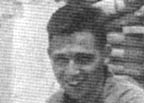 |
A month ago Specialist 4 Joseph P. Kern graduated from the lightning Combat Leadership Course and became a Staff Sergeant in a single bound; In Frontier City he took over the mortar platoon like an old pro. |
| Dubbed the ‘Mad Manchu’ by his troops, Major Harry D. Ray, Jr., coordinated the battle from a large tower and came down grimly satisfied. |  |
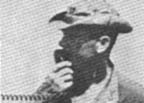 |
Captain Ramon T. Pulliam, Charlie Co commander, moves to the sound of guns – at a critical point in the defense he manned an M-60 on the perimeter. |
Lucky GI Escapes Enemy Prison Camp
By 1Lt. Mack D. Gooding
TAY NINH
– “It’s a GI! Hold your fire.”
These words crackled over
the air from a Light Observation Helicopter to a Cobra gunship signaling the
beginning of a dramatic rescue operation.
Warrant Officer Carl D.
Gray, Vinita, Okla., from C Troop, 3d Squadron, 17th Cavalry, was piloting LOH
over the enemy-infested jungles of War Zone C, 14 miles northwest of Tay Ninh,
on a typical early morning reconnaissance for the 1st Brigade.
Passing over a stream bed he
spotted a figure clad in black pajamas leaning against a tree by the bank.
“I called for
clearance to open fire and was beginning my gun run when I saw that he was an
American,’’ said Gray. “I
thought it might be a trap, because he looked like he was lashed to a tree.
His arms were waving back and forth but his body appeared to be glued to
the tree.”
“When we started to
descend we had to come straight down. Trees and shrubbery were right up to the
stream’s edge,” recalled First Lieutenant Claude H. Nix, Dalton, Ga.
Nix, the observer in the LOH,
praised Gray’s flying ability, “I didn’t think we could possibly get in
there but he did it. Once we were
down, our skids started to sink into the mud and we knew we had to get out fast.
Carl pulled up quick, popped the skids out of the mud and hovered
there.”
ONCE
THE SHIP
was hovering, Specialist 4 Dale E. Wampler, Everett, Wash., the LOH crew chief,
jumped to the ground to assist the GI to the chopper.
The soldier was Specialist 4 Thomas Van Patten, of the 332d Engineer
Company and a prisoner of the enemy for more than a year.
He was captured on February 10, 1968, when the convoy he was on was
ambushed between Tru Bi and Phien Ngon north of Tay Ninh.
“When I got to him, he
looked terrible. He was extremely
thin and seemed dead tired. I
helped him over to the LOH and got him strapped into my seat,” said Wampler.
THE
LOH COULD
hold only four people and Van Putten made the fifth man.
One man had to give up his seat and remain on the ground. Wampler
grabbed his M-60 machinegun and 250 rounds of ammo and made for the bushes.
The Cobra circled overhead to protect him.
“I didn’t have time to really think about anything,” said Wampler.
“There was a mission to be performed and I had my part to do.
I was scared the whole time but I knew that the Cobra would help me if I
got into trouble.”
The LOH took Van Putten to
the nearest friendly troops, a column of the 4th Battalion
(Mechanized), 23d Infantry, of the 1st Brigade, who were sweeping two miles from
the stream bed. It then returned to
pick up Wampler.
“IT
SEEMED
as though the LOH was gone for hours while we circled,” said Warrant Officer 1
Jonathan Watkins of Redlands, Calif., the Cobra pilot.
“Actually, it was only gone about 15 minutes. The whole time Wampler was down there, he had no means of
communicating with us. We lost
sight of him when he hid in the bushes
(Continued on
Back Page)
|
There
once was a sergeant named Saharia |
Page 2 TROPIC LIGHTNING NEWS May 5, 1969
Decorated
| Bronze Star
Medal (Heroism) |
|
|
SP4
John C. Clancy, Co D, 2d Bn, 12th Inf |
SP4
Mike Miller, Co A, 2d Bn, 14th Inf |
Sons
Granted Exemption of Sole Survivors
For many years the Army has
granted certain soldiers the option of being exempted from duty in areas of
active combat operations. These
soldiers are known as ‘sole surviving sons.’
A sole surviving son is the
only remaining son in a family that has lost one or more of its members, male or
female, as a direct result of hazards involved in service in the Armed Forces of
the United States. Certain persons
may qualify in instances where the other family member is currently in a
prisoner of war or missing-in-action status, or is permanently 100 per cent
disabled.
In addition the Military
Selective Service Act of 1967, under which Selective Service registrants are
inducted, provides that a sole surviving son of a family is not eligible for
involuntary induction except during war or national emergency as declared by
Congress.
A soldier who qualifies for
and desires exemption from assignment to active combat areas must apply to his
unit personnel officer. He will
annotate the records to preclude assignment to an active combat area.
One of the soldier’s
parents may request an exemption by writing to the Chief of Personnel
Operations, Department of the Army, Washington, D.C.
Such an exemption does not limit a soldier to service in the U.S. and, at
any time, the soldier may waive his assignment limitation with regard to combat
areas.
The Army will discharge any
enlisted man who becomes a sole surviving son of a family after his induction or
enlistment, emergency declared by Congress.
A soldier who is an only
son, the last male member of the family, or a sole surviving son in a family
where others have died for reasons not directly a consequence of military
service is not eligible for special consideration.
Toe
Line on Personal PM, Surgeon Urges
Rainy Season Makes Foot Care Vital
CU
CHI -
With the start of the rainy season, soldiers who are no longer wet behind the
ears will be making sure they’re not wet between the toes.
Captain Frank W. Clarke,
administrative assistant to the division surgeon, urges Tropic Lightning
soldiers to “be aware of the special hazards to health associated” with the
rainy season in Vietnam.
“Skin disease is by far
the biggest threat to combat effectiveness seen in the wet season,” Clarke
says. ‘The vast majority of skin
problems involve the feet.”
The experience of the U.S.
9th Infantry Division, which has probably slogged through more soggy boondocks
than any unit in Vietnam, has led to a series of what might be called rules of
big toe for foot care.
Clarke lists the series of
preventive measures, which are always subject to tactical considerations, as
follows:
(1) Avoid keeping troops in
flooded areas for more than 48 consecutive hours, and try to keep them in
relatively dry areas for the 24 hours after using them in wet terrain.
(Indications are that skin problems can cut into combat effectiveness after 48
hours in flooded areas.)
(2) Change socks as often as
possible, placing wet socks over helmets to dry when on the move.
(3) Use a lot of foot powder
with each change of socks.
(4) Wear shower shoes as
much as possible when in fire support bases and rear areas to give the feet
exposure to light and air.
Clarke adds that the
division is currently trying to make shower shoes an items of general issue.
PACEX
Asks Customers:
Have Patience
SAIGON
- The Japan Regional Exchange, already swamped with orders for merchandise in
the PACEX mail order catalog, finds itself further hampered now by a flood of
letters from customers wanting to know the whereabouts of their orders.
Col. Frederick M. Griggs,
JRE commander, has asked for assistance “in helping us reduce the present
workload generated by inquiry letters from customers concerning the status of
their mail orders which we cannot deliver on a timely basis.”
In a letter to Col. John R.
McDonald, commander of the Vietnam Regional Exchange, Griggs said the major
problem faced by the Japan Exchange is the inability of local vendors to produce
merchandise fast enough to meet the demand.
“Consequently, we receive
an excessive number of inquiry letters from customers who expect delivery within
30 days or sooner,” Griggs said.
ENORMOUS
RESPONSE
to the 1969 PACEX Mail Order Program - especially from servicemen in Vietnam -
has swamped the staff of the Japan Exchange for months.
The Exchange had a backlog of 30,000 orders before it hired additional
employees to cope with merchandise requests.
Griggs asked that Vietnam
customers be made aware that these items will be delayed from 45 to 60 days
prior to shipping because of the manufacturers’ production problems.
“Customers should also be
advised to allow sufficient time - a minimum of 75 days – for delivery of
merchandise before writing to the PACEX Mail Order Branch, as premature
follow-up tends more to add to the delay since orders are pulled from processing
action to answer correspondence,” Griggs added.
TO
GRIGGS’ ADVICE
officials of the Pacific Exchange System add these suggestions to customers who
want their PACEX mail order gifts to reach their destination without further
delay and unnecessary customs charges: (1)
complete the required customs declaration (POD Form 2966) with the purchase
order, and (2) sign the purchase order attesting to your status of entitlement.
MILITARY
PERSONNEL
in Vietnam may send bona fide gifts valued at $50 or less duty free. They may not mail gifts to themselves. For sets of items mailed in two or more packages because of
size and weight limitations, customers must fill out as many customs tags as
there are packages.
Customs declaration forms
are available for customer service counters and at postal facilities.
No
Room in the Inn
Army bulletins, to students
of the literature, provide deep and sometimes thrilling insights.
Some are models of tease
urgency: Napoleon to Massena,
“For God’s sake, come at once.” Others
contain exasperating rebukes: F.E.
“Galloper” Smith to young Winston Churchill, “Friends here hope you will
not continue making further ass of yourself.”
Often bulletins have a low
reputation for accuracy. “To lie
like a bulletin” is an expression once current in the French Artillery.
Occasionally bulletins
address themselves to the convenience of the troops.
For instance, II Field Force recently urged the widest possible
dissemination of this hot item:
“The above reference is
quoted for information and guidance: The
Embassy (in Tel Aviv, Israel) has conducted a survey of the hotel situation in
Tel Aviv for the months July through October.
With few exceptions, all hotels are fully booked for this period.
All commands should be notified of this tight situation.
Our experience has shown that hotel space requires as much as two months
of advance notification from May 1st.”
All are confident that II
Field Force will continue to supply the latest in hotel information for all the
international smart places. Like
Thule, Taskent, Ulan Bator and Kokomo, Ind.
TROPIC
LIGHTNING
Combat Honor Roll
 Specialist Four Dennis W.
Greeley has earned a place on the 25th Infantry Division Combat Honor Roll for
helping save the lives of two comrades and coordinating gunship support during a
March 29 battle.
Specialist Four Dennis W.
Greeley has earned a place on the 25th Infantry Division Combat Honor Roll for
helping save the lives of two comrades and coordinating gunship support during a
March 29 battle.
Greeley, a radio-telephone
operator for C Company of the 4th Battalion (Mechanized), 23d Infantry
Tomahawks, also was awarded a Silver Star for his actions, which came during an
intense enemy attack during a reconnaissance-in-force.
During the initial contact,
a Tomahawk armored personnel carrier was hit by a rocket-propelled grenade,
disabling the vehicle and wounding its crew.
Greeley, braving a heavy volume of hostile fire, moved to the stricken
APC and evacuated a wounded man to safety, then returned to the track to rescue
a second comrade.
After assuring himself that
the wounded were being cared for, Greeley worked to coordinate the medical
evacuation and gunship helicopters called to the scene to aid the Tomahawks.
The action was part of a
two-day battle during which the Tomahawks killed 39 NVA soldiers.
Greeley’s battalion
commander, Lieutenant Colonel G.E. Taylor, Shelby, N.C., praised the performance
of his men this way: “They were
great, and performed like professional soldiers.”
WELL
DONE
- (Above, right) Major General Ellis W. Williamson, 25th Division commander, congratulates
Specialist 4 Dennis W Greeley, the latest addition to the Tropic Lightning
Combat Honor Roll, after awarding Greeley a Silver Star.
The TROPIC LIGHTNING NEWS is an authorized publication of the 25th Infantry Division. It is published weekly for all division units in the Republic of Vietnam by the Information Office, 25th Infantry Division, APO San Francisco 96225. Army News Features, Army Photo Features, Armed Forces Press Service and Armed Forces News Bureau material are used. Views and opinions expressed are not necessarily those of the Department of the Army. Printed in Tokyo, Japan, by Pacific Stars and Stripes.
MG Ellis W. Williamson . . . . Commanding General
MAJ John C. Fairbank . . . . . Information Officer
1LT John C. Burns . . . . . . . . Officer-in-Charge
SP4 Robert Imler . . . . . . . . . . Editor
SP4 Charles Withrow . . . . . . Assistant Editor
SP4 Jim Brayer . . . . . . . . . . . . Production Supervisor
Page 3 TROPIC LIGHTNING NEWS May 5, 1969
McComas
Earns Trip in USARV Competition
Regular
Gets Free Sydney R&R as No. 100,000
CU
CHI -
A much decorated Tropic Lightning soldier has won an all-expense paid, nine-day
vacation in Australia for being chosen as the Army’s 100,000th R&R to the
Land Down Under.
Staff Sergeant Ernest L.
McComas, Hillsboro, Ohio, of the 3d Battalion, 22d Infantry, earned the trip by
winning an elimination contest that started at company level and ended with 21
finalists from Army units all over Vietnam appearing before a USARV board.
McComas, who’s won the
Silver Star, the Bronze Star for Valor, the Army Commendation Medal for Valor,
and the Purple Heart since coming to Vietnam last July, received a complete
wardrobe for his travels in addition to the free vacation.
He also received a $25 check
and a “bon voyage” from 25th Infantry Division Commander Major General Ellis
W. Williamson.
“I was out in the field
one day when they told me to get on a helicopter and go back to our base camp at
Tay Ninh,” McComas said. “They
told me I was going to represent the battalion in the division competition, and
sent me to Cu Chi. I’m still a
little dazed by it all.”
McComas, 21, is the son of
Mr. and Mrs. James O. McComas, RR 2, Hillsboro, Ohio.
 |
| GOING DOWN UNDER - Staff Sergeant Ernest L. McComas of Hillsboro, Ohio, talks with Division CG, Major General Ellis W. Williamson, about his trip to Australia. McComas was the Army's 100,000th R&R to Australia. |
Rocketeers
Bag VC Ammo Caches
TAY
NINH
- Working the rocket belt surrounding Tay Ninh Base Camp, the 3rd Battalion, 22d
Infantry Regulars recently captured 53 107mm rockets.
Also captured during the
operation were two mortar tubes.
Under the command of First
Lieutenant William Ervin of Brunswick, Ga., A Company uncovered a 120mm mortar
tube complete with bipod legs, base plate, aiming quadrant and tube.
At the same enemy base camp 11 kilometers northwest of Tay Ninh, an 82mm
mortar tube was discovered. Both
tubes were found by the use of a mine detector.
The Regulars had assaulted
the enemy base camp and met heavy resistance.
Utilizing Cobra gunships from the 187th Helicopter Company and the 3d
Battalion, 17th Cavalry, artillery from the 7th Battalion, 11th Field Artillery,
and air strikes, the Tropic Lightning troops forced the enemy to evacuate his
own base camp.
The next morning A and B
Companies combat assaulted into the camp to see what was left. The quick thinking of Lieutenant Colonel Robert Carmichael of
Columbus, Ga., brought the mine sweeper to aid in finding hidden enemy weapons.
The move paid off with the discovery of the two mortar tubes.
A few days after the find of
the tubes, rockets became the point of interest.
While on an ambush patrol, A
Company spotted three enemy soldiers setting up 107mm rockets to be fired at Tay
Ninh Base Camp. Pursuing the enemy
soldiers, the Regulars captured the rockets before they could do any harm.
During the next several days
A and B Companies captured more and more rockets.
Staff Sergeant Donald W.
Roberts of Weymouth, Mass. Made the first find.
“It seemed that no matter where I ran the mine sweeper, it clicked;
I thought that maybe we had come across a gold mine,” said Roberts.
B Company might as well have
found a gold mine. 28 107mm Chinese
Communist rockets were found at that location.
| COUNT-OFF - Staff Sergeant Curtis Daniels of Deer Park, Tex., smiles over the 28 107mm Chinese Communist rockets captured by B Company, 3d Battalion, 22d Infantry. The Regulars captured a total of 53 rockets in 19 days. (PHOTO BY SP4 DAVID DE MAURO) |  |
|
|
|
FAMILY PORTRAIT – First Lieutenant Danny Goins of Atlanta stands beside this 120mm mortar captured by infantrymen of the 1st Brigade. (PHOTO BY SP4 DAVE DE MAURO)
|
Leftover
Mascot Shows 7/11 Arty He’s No Chicken
TAY
NINH
- Charlie Battery of the 7th Battalion, 11th Artillery, may have the Army’s
only mascot that is a Thanksgiving leftover.
Last November, Sergeant
First Class Edwin Borrero, Guayanilla, P.R., had a problem. Borrero is the mess sergeant for Charlie Battery, and with
only one week remaining before Thanksgiving it appeared he wouldn’t receive
turkey rations for Thanksgiving Dinner.
With the troops’ morale in
mind, Borrero purchased a turkey. But
when Thanksgiving came, there were enough turkey rations for Thanksgiving Dinner
- the turkey wasn’t needed; It
was decided to save him for Christmas.
The turkey was soon named
Bozzell (for no apparent reason), and by the time Christmas rolled around the
men had grown so attached to Bozzell that the thought of eating him was out of
the question. Bozzell became the
battery mascot.
When Bozzell first came into
the battery he was deathly afraid of the 105mm howitzers. They seemed to scare the stuffing out of him.
But he has since grown accustomed to them and now trots around talking
turkey to the gunners during fire missions.
In the last five months, Bozzell has survived mortar and rocket attacks,
as well as hundreds of fire missions.
He currently resides at Fire
Support Base Ord in Thein Ngon, where Charlie Battery is providing direct
artillery support for the rebuilding of the air strip there.
 |
A MAN AND HIS TURKEY – Sergeant First Class Edwin Borrero of Guayanilla, P.R., the mess sergeant for C Battery, 7th Battalion, 11th Artillery, holds Thanksgiving leftover Bozzell. |
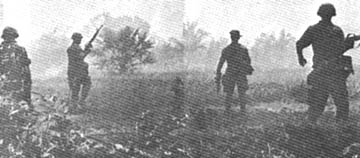 |
| ASSAULT TEAM - Platoon Sergeant Ronald S. Figueroa of Miami (second from left), waves on an assault element from Bravo Company of the 4th Battalion, 9th Infantry. With smoke from preparatory gunship strikes still rising, the Manchus moved in to check out a thicket near the Cambodian border. (PHOTO BY SP4 RALPH NOVAK) |
Page 4-5 TROPIC LIGHTNING NEWS May 5, 1969
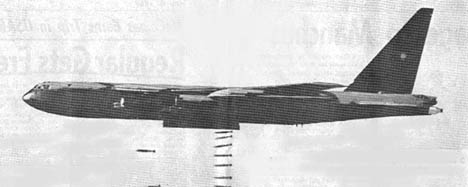 |
| BABY, THE BOMBS MUST FALL – High over War Zone C a B-52 begins dropping some 30 tons of bombs. |
Bring
Down The Thunder
In the lower corner of War
Zone C, a company of North Vietnamese troops ends its afternoon’s march in a
bunker area seemingly secure in jungle shadows.
Suddenly a short whoosh sounds across the sky and the earth tosses as
huge explosions range the length of the bunker complex, collapsing fighting
positions and store pits, hurling trees into the air and gouging great craters
in the earth.
As columns of dust and smoke
rise into the air, the stunned NVA, some bleeding from the nose and mouth from
the concussion, move to dig out their comrades from collapsed bunkers.
Those who had been within the effective bursting radius of the bombs have
been annihilated.
The Strategic Air Command,
under whose protection the cities of the Western World have lived in peace for a
generation, has pinpointed a tiny target and erased it with 90 tons of bombs
from three aircraft.
Before the B52s are
launched, the 25th Division’s request for air strikes is coordinated with the
Commander in Chief of the Pacific and the Joint Chiefs of Staff. SAC headquarters in Omaha then directs the 3d Air Division to
make the strike. The 3d Air
Division, which received a copy of the MACV request, has completed its plans and
is ready to launch when the OE comes from Omaha.
Each B52 mission begins with
nearly two hours of preflight briefings, target study, and aircraft checks.
Within three hours of takeoff, the bombers are met by tanker aircraft and
refueled over the Pacific. If
necessary, the planes are refueled again on their return trip.
Between refueling and the bomb run, the six-man crews, consisting of a
pilot, copilot, radar navigator, navigator, electronic countermeasures officer
and gunner, can relax a little.
As the mission approaches
Vietnam, the latest reports from Forward Air Controllers, troops in the field,
people-sniffing teams and other intelligence sources are being analyzed.
The bombers are flexible, and if the situation demands they can still be
vectored to drop their 90 tons of bombs on another target.
Once over Vietnam, the
planes are in constant touch with the ground and the 7th Air Force’s radar
stations. This time, as usual, no
need has arisen to divert the mission to another target.
The planes fly on, seven miles high
at 500 miles per hour, toward War Zone C.
As the planes settle into
their bomb run, a Forward Air Controller aircraft from the Tropic Lightning
tactical air control party takes station to observe the strike and assess
damage. The FAC flies well clear of
the drop zone at an altitude of 2,500 feet.
The drop zone is usually a
rectangle one kilometer wide and three kilometers long, but the actual target is
usually a much smaller area. Just
hitting the rectangle is like emptying an M-16 at full automatic into your DEROS
orders at 150 meters in a 40 mile-per-hour gale.
Invisible in the sky above,
the B52s open their bomb bay doors. The
bombs drop, and the aircraft, suddenly 60,000 pounds lighter, spurts ahead.
The bomb bay doors snap shut, and the huge gray planes bank around and
head for home.
The immediate physical
damage of a B-52 strike can be quickly assessed, and the tally is large.
More than 3,000 bunkers have been destroyed already this year in the
Tropic Lightning area. Fires and secondary explosions indicate precious ammunition
and supplies denied to the enemy. What
cannot be assessed is the damage not done to the allied cause because of an air
strike. Each company broken, each
bunker complex destroyed, lightens the hand of Viet Cong terror on the country
side, reduces the level of extortion and confiscation the enemy can impose.
The Viet Cong fear the
bombers as no other weapon on the war is feared.
B-52 strikes are one of the biggest reason enemy soldiers Chieu Hoi.
“There’s no place to
hide, no warning,” one Hoi Chanh said.
In one way B52 strikes are
like an urban renewal project. Substandard
housing is destroyed, and swimming pools are provided to many who would not
ordinarily have access to them. Craters
from the strikes are often 30 to 40 feet wide and 15 to 20 feet deep. More often
than not they fill with clear, turquoise water, and it’s an unfeeling dog
handler that won’t let his tracker dog paddle a bit.
Charlie likes to splash
around in the craters too. Occasionally
he’ll be spotted by helicopter and troops brought in to police him up he tries
to scramble up the steep sides. For
Charlie, cleanliness can be next to captivity.
But after the bombs fall, the craters are more ominous than enjoyable.
The holes in the jungle floor will remain for years, testimony to the
concussion that put new cracks in the masonry of the old French fort, 12 miles
to the east, and to the ground tremors that set tanks dancing in the streets of
Tay Ninh, 10 miles southeast.
Through the blasted jungles
of War Zone C, an infantry company sweeps toward the target area.
The dust clouds raised by the bombs are fading off to the north.
Small fires crackle on remains of structures.
An NVA, his face caked with
dirt and dried blood, stumbles toward the Tropic Lightning point man.
He sees the American and raises his hands over his head. “Chieu Hoi,”
he says, “Chieu Hoi.”
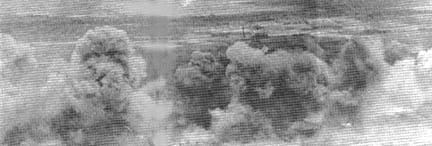 |
| EXPLOSION – Clouds of smoke and dust rolling skyward obscure all signs of the target, except for the flame at right where a structure burns. |
| Photos by U.S.A.F. unless otherwise credited |
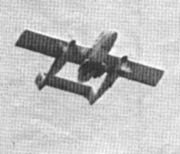 |
LOOK – After the last bomb has fallen, a Forward Air Controller’s Bronco swoops in to assess the damage below. (PHOTO BY SP5 DENNIS JOHANSEN) |
| AFTERWARDS – From the air the FAC spotters can see where the bombs have revealed and wrecked enemy bunkers, even with a near miss. | 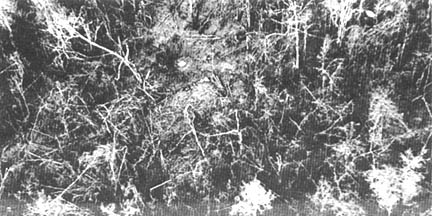 |
|
| INTO THE SKY – Under full power a B-52 storms into the Pacific sky on its way to Vietnam. |  |
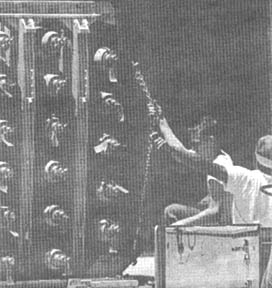 |
RACK ‘EM UP – Ground crewmen maneuver part of a B-52’s 30-ton load toward the open bay. |
| TO THE LINE – Flight crews are brought out to their aircraft by buses. It’s one of the slowest trips they’ll make for many hours. | 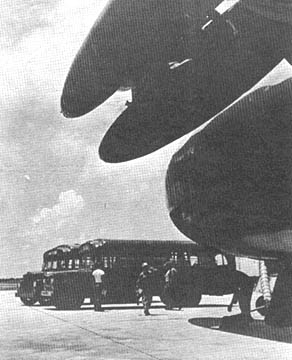 |
Page 6 TROPIC LIGHTNING NEWS May 5, 1969
 |
HAPPINESS IS A letter from your wife bringing the good news that you’re about to become a father. First lieutenant James Mitchell, Theodore, Ala., of the 4th Battalion (Mechanized), 23d Infantry, reads that he’s a father-to-be here. (PHOTO BY SGT ROGER WELT) |
Triple
Deuce, RFs Find Four Caches
DAU
TIENG
- Mechanized infantrymen of the 2d Battalion, 22d Infantry, with the help of two
Vietnamese Regional Force companies from Khiem Hanh District, recently uncovered
four enemy weapons caches in the Boi Loi Woods near here.
The Triple Deuce’s C
Company and the 872d RF Company located three caches that netted 120 recoilless
rifle rounds, 26 RPG rounds, a 57mm recoilless rifle, 250 mortar rounds, and
more than 100 hand grenades.
Parcels
Bring Message to Manchus
TAY
NINH
- Five gift packages that arrived recently at Company A, 4th Battalion, 9th
Infantry Manchus, contained useful material - candy, toilet articles, pens -
articles soldiers are always glad to get.
But more important, the
packages contained an unwritten message of concern and understanding that had
risen through the grief of the family of a man killed in Vietnam.
First Lieutenant James C.
Adams, a platoon leader with Company A, was killed in action November 27, 1968.
Shortly thereafter, five gift packages addressed to him arrived at the
battalion mail room, and were sent back to the United States.
The packages, however, were
intended as Christmas presents for the men of Adams’ company. They had been collected by Adams’ sister, Mrs. Douglas R.
Lawrence, Washington, D.C., through the Women’s Missionary Union’s Mission
Action Committee of Forestville Baptist Church, Forestville, Maryland.
In a letter that accompanied
the packages, the church’s pastor, Richard J. Sweetman, wrote that Mrs.
Lawrence “planted the idea of Christmas in Viet Nam in the minds and hearts of
the Committee, and after that the idea grew and the gifts started coming in.”
“Your loved ones back home
keep you constantly in prayer and in their thoughts,” Sweetman wrote the 25th
Division soldiers. “We are,
indeed, proud of our fighting men, but will rejoice when you will spend
Christmas with your loved ones once more.”
After the packages were
returned to the States, Adams’ brother-in-law wrote Manchu Battalion Commander
Lieutenant Colonel Lee L. Wilson, Salina, Kans., to say that he and his wife
were sending them back to Viet Nam.
“Good luck to you and all
the men there, and may these parcels bring some comfort to each of you as, you
receive them,” Lawrence said. “I
would also hope the knowledge that the gifts are with the men as intended will
bring comfort to our grieved home.”
Wilson replied to thank the
Lawrences for their “thoughtful, gracious act in sending gifts to our men.”
“Troops in the field are
constantly in need of the small things we take for granted at home, of course,
and I can assure you nothing sent will go to waste,” Wilson added. “But the
material value of the gifts is far outweighed by the truly Christian concern and
interest you and your fellow church members have shown.”
Wilson also thanked the
family for showing that “those at home are aware of and understand the
sacrifices American and other Allied forces are making in Viet Nam.”
“Acts such as yours show
that such understanding is, indeed, the rule rather than the exception,” he
added.
“Since I did not take command of the battalion until December, I
did not know Lieutenant Adams personally,” Wilson said.
“I do know him, however, by his reputation, that of an officer and a
gentleman in the best American tradition. Allow
me to convey my condolences on your loss even as I congratulate you for honoring
his memory so well.”
| GIFTS WITH MEANING - These Christmas packages arrived a little late at A Company, 4th Battalion, 9th Infantry Manchus, but they arrived with a little extra meaning, too. The gifts, collected by members of a Forestville, Md. church, were originally sent to be distributed by a Manchu platoon leader killed in action November 27. The packages were returned to his sister unopened, but she resent them to Viet Nam to fulfill her brother’s wishes. |  |
Cav’s
Air Ambulance Saves Lives
CU
CHI -
The 3d Squadron, 4th Cavalry, is in contact with Charlie and has taken some
casualties. The call for a dustoff
is heard in Operations at D Troop in Cu Chi.
One long blast of the alert horn scrambles a slick, and four minutes
later the ship is airborne with a medic on board.
In the month of February,
Centaur pilots flew 50 dustoff sorties for the ground troops of the cavalry
squadron. These missions have taken
82 casualties to 12th Evacuation Hospital in Cu Chi. The average time elapsed from the call for a dustoff until
the casualty arrives at 12th Evac. is 20 minutes.
Captain William Reavis, who
flew approximately 15 dustoffs in February, says that D Troop can offer such
fast service because they always know the area in which the Cav is working, and
are familiar with the call sign of the Squadron.
This information saves valuable minutes on a dustoff.
Specialist 5 William Wismann
of Philadelphia, Penn., a medic attached to B Troop, has nothing but praise for
the dustoff pilot. “The wounded
personnel will be evacuated regardless of how hot the LZ is,” says Wismann.
Wolfhounds
Plus Gunships Equal Rough Day for VC
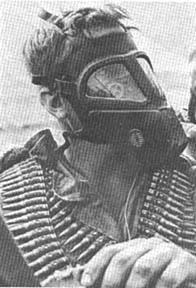 CU
CHI -
Charlie Company, 2d Battalion, 27th Infantry Wolfhounds recently made contact on
a reconnaissance-in-force near
Trang Bang, killing two Viet Cong and detaining one suspect.
CU
CHI -
Charlie Company, 2d Battalion, 27th Infantry Wolfhounds recently made contact on
a reconnaissance-in-force near
Trang Bang, killing two Viet Cong and detaining one suspect.
“We were just going into
our first objective,” said Captain Thomas Vesser, the company commander from
Knoxville, Tenn., “when we received fire from a small enemy element.”
Staff Sergeant Carl Grissom
of LeGrand, Cal. said, “They opened up with rifle fire, but we returned fire
and silenced the positions.”
As the 2d Brigade soldiers
moved forward to sweep the contact area, they received another flurry of fire,
this time from rocket-propelled grenades and machineguns as well as rifles.
Gunships and artillery were called in to aid the Tropic Lightning
troopers.
“The gunships were
great,” said Specialist Four Thomas Ralph of Arroye Grande, Cal. “They
really tore up the place and chased off the VC they didn’t kill.”
With the gunships flying
cover, the Wolfhounds surged forward again to sweep the area, and this time met
with no resistance.
NEW
PROTECTlVE MASK
- (Above, right) On a mission near the Cambodian border, a Wolfhound trooper from A Company, 2d
Battalion, 27th Infantry dons the new light weight protective mask.
(PHOTO
BY SP4 ROBERT B. WILLIAMS)
Page 7 TROPIC LIGHTNING NEWS May 5, 1969
Ayers’
Acres Ready for Monsoon
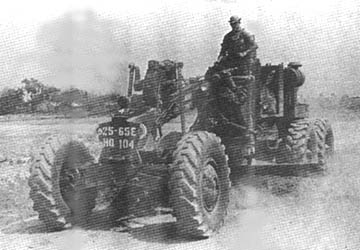 In the afternoons recently
Charlie Company of the 65th Engineers achieved the destruction of Fire Support
Base Ayers, a goal that eluded the Viet Cong for two years.
In the afternoons recently
Charlie Company of the 65th Engineers achieved the destruction of Fire Support
Base Ayers, a goal that eluded the Viet Cong for two years.
But the significance of the
destruction of a redundant fire support base and the salvage of its materials is
found in the G-5 project that followed.
Ayers’ acres of rich,
silicate soil in the past supported lush rice paddies. With the coming of the
fire support base, dikes and run-off channels were bulldozed into the ground,
and the productivity of some dozens of rice paddies was lost.
In order to restore the
usefulness of the land and demonstrate to the Vietnamese that the U.S. forces
respect their property, Major General Ellis W. Williamson, division CG, ordered
the rebuilding of the paddy dikes and water channels.
In the interests of supply
economy, all useful sandbags and all other salvageable materials were retained
for use in other bases. Then
bulldozers of the 65th Engineers, under the supervision of G-5, put up new paddy
dikes, sparing the farmers many days of pick and shovel labor. As a final touch, the road through the area was regraded to
give farmers better access to their land.
Lieutenant Colonel Jefferson
K. Rodgers of Walsenburg, Colo., G-5 supervisor of the project, said the project
seemed to be producing the hoped-for results.
“The farmers were happy that we restored the land in its original
condition,” he said.
“The significant thing is
that we wanted to turn back the land exactly as we found it,” Rodgers said.
“The farmer should have a much better attitude toward us.”
The better attitude is
already apparent. “A little kid brought me a grenade he’d picked up,”
Rodgers said, noting an improvement over the method in which grenades are often
given to soldiers.
ACCESS
– (Above, right) With the paddy dikes and water channels restored, the engineers
re-grade the
road so the farmers can get to and from their land.
 |
 |
|
| CHECKING UP - When Lieutenant Colonel Jefferson K. Rodgers of G-5 (left) and Captain Ronald E. Cox, his assistant (center), came out to supervise the project, they found a small tribe of Vietnamese children checking up on them. Captain Cox’s camera was approved. | CO-ORDINATION - Lieutenant Colonel Jefferson K. Rodgers and Captain Ronald E. Cox confer with a team from the 65th Engineers about clearing the site of the fire base. |
Page 8 TROPIC LIGHTNING NEWS May 5, 1969
A,
D Troops Rout NVA Ambushers, Slay 86
3/4
Cav Rides to Rescue of Convoy
By SP4 Larry Vallelonga
CU
CHI -
Alpha Troop of the 3d Squadron, 4th Cavalry turned what was supposed to be a
late morning NVA ambush into an all-day NVA disaster recently killing 86 enemy.
The Cavalry troopers had
just begun a sweep through the Boi Loi Woods, when a call for assistance came
from the daily Cu Chi-Dau Tieng resupply convoy.
THE
CONVOY
had been hit with an attempted ambush and was receiving heavy fire from an
unknown size enemy force. Reinforcements
were needed.
Within 15 minutes, an entire
cavalry troop and the aero-rifle platoon from the Cav’s Delta Troop were on
the scene.
Enemy fire died as the
Horsemen proceeded against the NVA positions, which ran parallel to the resuppy
route along the edge of a woodline and in bamboo thickets.
THE TROOPERS
fought their way between the convoy and the woodline and sprayed a barrage of
automatic weapons fire into the face of the enemy.
The convoy was then able to pass safely.
As soon as the last element of the convoy drove by, air strikes were
called onto the NVA positions. While
waiting for jet fighters to arrive, the Tropic Lightning troops called for
artillery support to hit enemy concentrations.
When the air strikes began
the cavalrymen pulled back to let them engage their targets.
After a 3d and final strike, the Cavalry’s Delta Troop pounded the area
with rockets and mini-gun fire from gunships.
Soon the cavalrymen were
right on top of trenches throwing grenades into them and putting fire on NVA
trapped between armored personnel carriers and Sheridan tanks.
The fighting grew more fierce as the Cavalrymen went deeper into the
wooded area.
Two Chicom .30 caliber
machineguns, firing from dug-in positions, were silenced and later captured as
the ground troopers from Delta Troop’s aero-rifles tossed grenades into the
bunkers. Also destroyed during the
fighting was an antiaircraft machinegun.
A subsequent sweep of the
battlefield the next morning revealed that the enemy literally abandoned the
area of combat. Thirty-one
additional enemy bodies were found, as were two more Chicom machineguns, 10
AR-47 rifles, .51 caliber ammunition, 10 82mm mortar rounds and 2,000 rounds of
AR ammunition. The bodies and
weapons were found in a fighting position, bombed out positions and open fields.
| TRACK POWER – Troops from the 3d Squadron, 4th Cavalry blast away with a .50 caliber machinegun at a suspected enemy position. (PHOTO BY SP4 ROBINSON TRUITT) | 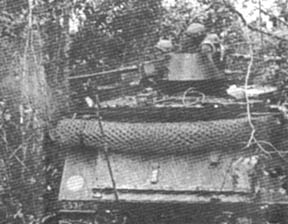 |
Tomahawk
Tactics Grab Gun
TAY
NINH
- In a classic example of how to neutralize an enemy automatic weapons position,
A Company, 4th Battalion (Mechanized), 23d Infantry, killed six North Vietnamese
Army soldiers and captured a .51 caliber machinegun, 12 miles east of Tay Ninh
City.
“My squad was skirting a
woodline when we received one or two rounds of .51 caliber machinegun fire,”
said Staff Sergeant Victoriano Riveria, Crystal City, Texas. “Then for some strange reason the enemy machinegun nest
stopped firing the .51 and opened up with AK47 rifles.
We crawled around to the sides of the position and tossed in several hand
grenades.”
After tossing the grenades,
the Tomahawks saturated the area with Light Anti-Tank Weapons completely
eliminating the enemy resistance, or so they thought.
“As I came up to the nest,
I spotted an NVA soldier drawing a bead with his AK-47 on one of my squad
members. I shot him before he had a
chance to open up,” said Specialist 4 Jerry Dossey of Denver City, Texas.
The
NVA were still not finished.
“I moved in to place some
explosives next to the bunker when I heard a noise come from inside.
I lifted off one of the logs protecting the bunker’s roof,” said
Specialist 4 Donald Davis of Scranton, S.C., an engineer from A Company, 65th
Engineers. “I saw an enemy
soldier sitting down with a weapon ready to fire.
I managed to reach for my .45 and get off a shot before he saw me.
When I went in to examine him, he was dead.”
The brief, hotly contested
firefight cost the enemy six NVA soldiers, one complete .51 caliber machinegun,
three AK-47 rifles, one pistol, and an assortment of web gear.
An examination of the anti-aircraft gun showed that it had jammed after
firing just two rounds. The
Tomahawks suffered no casualties.
Dug-In
Bobcats Eliminate 85 Enemy
By Sgt. Jan Anderson
CU
CHI -
A mechanized infantry battalion from the 2d Brigade killed 85 enemy soldiers in
four days of scattered action.
After a sweep the first day,
Company A of the 1st Battalion (Mechanized), 5th Infantry Bobcats together with
2d Battalion 34th Armor tankers, ARVN soldiers and division engineers set up a
night laager position, digging bunkers and putting up RPG screens.
At 3:30 in the morning the enemy launched a heavy mortar
attack on the night laager, and followed up with a ground assault.
SOON
AFTER
the first mortar round hit, Company Commander Captain Randall Yeargan, Sigouthey,
Iowa, maneuvered his ambush patrols back to the perimeter.
Sergeant James Jacobson of
Minnetonka, Minn., said: “Charlie really tried to pour it on us but we were
too well dug in.”
The following morning’s
search of the battlefield revealed 30 NVA bodies.
The nest night was
practically a repeat performance. At
almost the same early morning hour mortars were dropped on the night position.
This time the NVA used a .51 caliber machinegun to prepare the position before
they assaulted.
AT
DAWN
the 2d Brigade troopers searched the area and found seven enemy bodies. While Company A was busy with this action, the Bobcats’
Company C was called in to reinforce two infantry companies who were expecting
an attack. Working together the
“legs” and “mechs” built a fortified night location.
After dark the combined
units conducted a reconnaissance by fire of the surrounding area.
The next morning the Tropic Lightning soldiers found 22 enemy bodies.
TWO
DAYS
later, Company C was providing security for engineers working north of Cu Chi.
Again aided by tankers and ARVN soldiers, the mechanized infantrymen set
up a night location. About midnight, mortars began to rain on the night ambush
site.
Sergeant Charles Hathorn,
Laurel, Miss., commented: “We spotted NVA running with bangalore torpedoes.
It looked as though they were trying to surround us.”
STAFF
SERGEANT
Harold White of Yelm, Wash., fired several light anti-tank weapons (LAWS) at the
scurrying enemy and was praised for his part in warding off the attack.
The enemy used three .51
caliber machineguns to fire at gunships throughout the night. The mech’s .50 caliber machineguns finally silenced the
enemy’s antiaircraft positions.
The fight lasted for nearly
two hours, then the enemy broke contact and fled, leaving 26 dead and a small
cache weapons and equipment.
GI
Escapes VC Near Tay Ninh
(Continued from Page 1)
and
were really getting anxious about his safety.” Warrant Officer 1 Eugene Sellon of Anchorage, Alaska, the
Cobra‘s copilot, recalled, “When Gray came back to go in for Wampler, I was
sure he’d never make it. There
were some tricky crosswinds down there and all those trees and shrubs made it
doubly deadly. That he made it in
and then black out twice just confirms my belief that Gray is the best LOH pilot
in Vietnam.”
After Wampler had been
extracted, the LOH returned to the mechanized column, dropped him off again,
picked up Van Putten and flew him to the 45th Surgical Hospital at Tay Ninh Base
Camp. From there the escapee was
further medevacuated to Long Binh and finally to the States.
Gray commented, “There was
nothing particularly unusual about this mission, except the results.
Every day our unit flies where ground troops never go.
Today was just another example of this.”
Automatic
8th's Shields Protect Crews
CU
CHI -
Splash shields, a new development to reduce gun crew casualties, have proven
themselves to men of the 1st Battalion, 8th Field Artillery.
The shields, made of PSP
sheets, were developed by Major Michael MacDonald of Orlando, Fla., and Captain
Norvell Henn of St. Louis, Mo.
Henn, former battalion
logistics officer, and MacDonald, battalion executive officer, fostered the idea
of mounting splash shields in front and on the sides of M102 guns.
The purpose is to stop fragments from enemy mortars and RPG rounds.
Despite recent heavy
fighting at a Tropic Lightning fire support base, men of the Automatic Eight
suffered only one casualty, while putting out direct fire with 105mm howitzers.
“A lot of credit goes to
the section chiefs and crews of those two guns,” said MacDonald, “and the
splash shields an the guns definitely prevented a lot of casualties.”
According to MacDonald,
“One of the shields took a direct hit from an RPG but no one was injured.”
“We have seven of them
now,” said MacDonald, “and we’re having them made for all of our guns.
They are definitely life savers.”
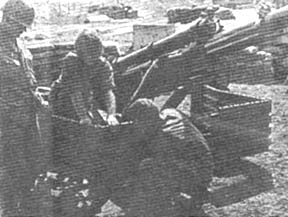 |
LIFE SAVERS - Men from Alpha Battery, 1st Battalion, 8th Field Artillery attach a “splash shield” to their howitzer. Mounting the shield are, left to right, First Lieutenant James O’Donaghue of Huntington, N.Y., Private First Class Tom Woodson, of Phoenix, Ariz., and Private First Class John Ledbetter of Winston, Ore. (PHOTO BY 1LT J. N. BLACK) |
Thanks to
Mack D. Gooding, 15th PID, 1st Bde., for sharing this issue,
Kirk Ramsey, 2nd Bn., 14th Inf. for creating this page.
This page last modified 8-12-2004
©2004 25th Infantry Division Association. All rights reserved.